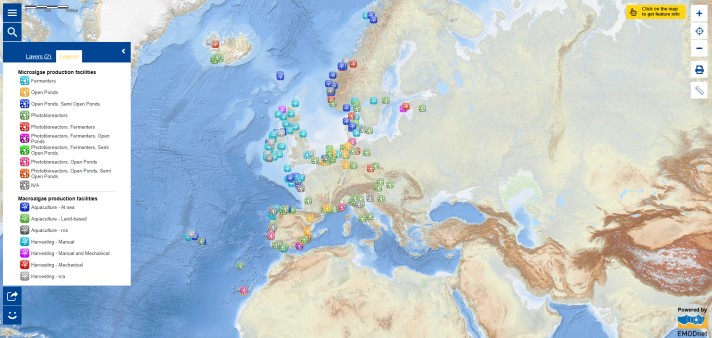Wednesday 16 October celebrated World Food Day, marking the founding of the United Nations Food and Agriculture Organisation (FAO) in 1945[1]. Celebrated through worldwide events, this year’s theme, “Right to foods for a better life and a better future”, emphasised the universal right to access healthy food. However, in 2024, food safety remains a critical challenge as climate change, overfishing, and pollution, continue to destabilise global food systems[2]. Ensuring that food is safe, nutritious, and sustainably sourced is key to maintaining a healthy global population[3]. These challenges are particularly relevant in the context of marine resources, where unsustainable practices threaten ecosystems and food security[4]. Therefore, transforming agrifood systems offers an opportunity to mitigate climate change while supporting peaceful, resilient and inclusive livelihoods for all[2] .
This week’s map spotlights algae production facilities across Europe, classified by production methods. Macroalgae are produced through harvesting and aquaculture, while microalgae are grown using photobioreactors, open ponds, fermenters, and combinations of these systems. As noted in the map layer description on microalgae production in the Atlas, microalgae are tiny plants typically found in freshwater and marine environments, residing both in the water column and in sediment. In contrast, macroalgae are the larger, more familiar seaweeds. Click on the map’s icons to learn more about the different production facilities and methods, as well as the species cultivated! Data were collected from Belgium, Denmark, Estonia, France, Germany, Ireland, Italy, Norway, Portugal, Spain, Sweden, and the UK.
Macroalgae, a long-standing staple in East and Southeast Asia, is gaining popularity in Europe for uses beyond food, including pharmaceuticals, cosmetics, nutrition, and biofuels[5]. The Global Seaweed Coalition (GSC) estimates that seaweed food production could increase the global food supply by 10%. This could help address land space limitations for a growing population, a major challenge identified by the FAO[2]. Moreover, it has the potential to absorb 135 million tons of CO2 annually and reduce ocean nitrogen pollution by 30% by 2050[6]. Therefore, across Europe, companies are increasingly engaged in algae cultivation and processing to produce valuable products[7].
To support algae production developments, the European Commission adopted the EU Algae Initiative in November 2022. It identifies 23 actions that contribute to the development of a robust and sustainable EU algae sector by 2027. As part of the EU’s Farm to Fork Strategy, under the European Green Deal, this initiative promotes algae as a sustainable protein source to address food security and environmental issues. Moreover, the EU4Algae Platform was created to scale up a regenerative, resilient, fair and climate friendly algae industry, as well as bring more novel algae species to the market. These efforts position algae production as a key component of the blue bioeconomy, promoting global food safety and environmental health.
Want to go further?
- On November 7, attend the online “BlueInvest x EU4Algae E-Pitching” session. A great opportunity to learn about innovant projects in the algae sector! Register now;
- Are you a teacher looking to dive deeper into the world of algae? Explore the interactive quiz available in the Atlas Teacher’s Corner and engage your students with fun, educational content;
- Visit the FAO’s webpage to learn practical ways you can contribute to improving food security in your community, from supporting sustainable practices to making informed food choices;
- Read Seaweed Europe’s report ‘Hidden Champion of the Ocean: Seaweed as a Growth Engine for Sustainable European Future’ and dive into the potential of seaweed as a transformative resource for a healthier planet.
The data in the map are provided by EMODnet.
[1] https://www.fao.org/about/about-fao/en/
[2] https://www.fao.org/world-food-day/about/en
[3] https://www.sciencedirect.com/science/article/pii/S0002916522005536
[4] https://water.europa.eu/marine/europe-seas/pressures-impacts
[6] https://www.safeseaweedcoalition.org/the-seaweed-revolution/
[7]https://www.europarl.europa.eu/RegData/etudes/STUD/2023/733114/IPOL_STU(2023)733114_EN.pdf

